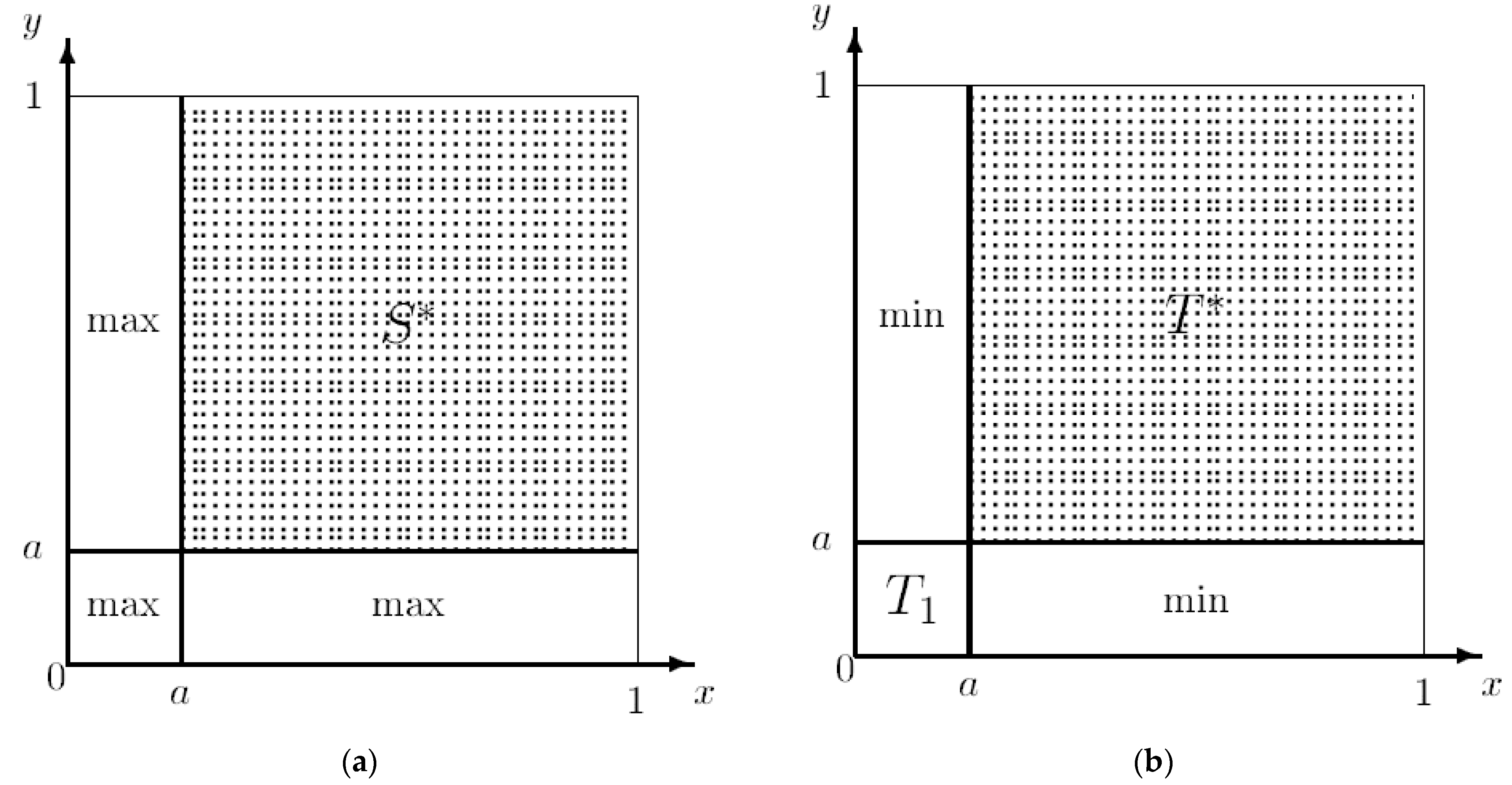Pseudo-Analysis as a Tool of Information Processing †
Abstract
1. Introduction
2. Pseudo-Analysis
3. Application: Fuzzy Logics and Fuzzy Sets
4. Application: Utility Theory
- probality measures (and T = product);
- possibility measures (and T is any t-norm);
- normalized hybrid measure m such that there exists a∈[0, 1] such that for M and N disjoint
5. Application: Cumulative Prospecct Theory
6. Application: Partial Differential Equations
Funding
Conflicts of Interest
References
- Grossman, M.; Katz, R. Non-Newtonian Calculus; Lee Press: Rockport, MS, USA, 1972. [Google Scholar]
- Burgin, M.S. Nonclassical models of the natural numbers. Uspekhi Mat. Nauk 1977, 32, 209–210. (In Russian) [Google Scholar]
- Pap, E. g-calculus. Univ. u Novom Sadu, Zb. Rad. Prirod.-Mat. Fak. Ser.Mat. 1993, 23, 145–150. [Google Scholar]
- Maslov, V.P.; Samborskii, S.N. (Eds.) Idempotent Analysis; Advances in Soviet Mathematics; American Mathematical Society: Providence, RI, USA, 1992; Volume 13. [Google Scholar]
- Mesiar, R.; Pap, E. Idempotent integral as limit of g-integrals. Fuzzy Sets Syst. 1999, 102, 385–392. [Google Scholar] [CrossRef]
- Pap, E. An integral generated by decomposable measure. Univ. Novom Sadu Zb.Rad. Prirod.-Mat. Fak. Ser. Mat. 1990, 20, 135–144. [Google Scholar]
- Pap, E. Null-Additive Set Functions; Mathematics and Its Applications; Kluwer Academic Publishers: Dordrecht, The Netherlands, 1995; Volume 337. [Google Scholar]
- Pap, E. Pseudo-analysis as a mathematical base for soft computing. Soft Comput. 1997, 1, 61–68. [Google Scholar] [CrossRef]
- Pap, E. (Ed.) Pseudo-additive measures and their applications. In Handbook of Measure Theory; Elsevier: North-Holland, The Netherlands, 2002; Volume II, pp. 1403–1465. [Google Scholar]
- Pap, E. A generalization of the utility theory using a hybrid idempotent-probabilistic measure. In Proceedings of the Conference on Idempotent Mathematics and Mathematical Physics; Contemporary Mathematics. Litvinov, G.L., Maslov, V.P., Eds.; American Mathematical Society: Providence, RI, USA, 2005; Volume 377, pp. 261–274. [Google Scholar]
- Pap, E. Generalized real analysis and its applications. Int. J. Approx. Reason. 2008, 47, 368–386. [Google Scholar] [CrossRef][Green Version]
- Dubois, D.; Pap, E.; Prade, H. Hybrid probabilistic-possibilistic mixtures and utility Functions. In Preferences and Decisions under Incomplete Knowledge; Fodor, J., de Baets, B., Perny, P., Eds.; volume 51 of Studies in Fuzziness and Soft Computing; Physica-Verlag, A Springer-Velag Company: Berlin/Heidelberg, Germany, 2000; pp. 51–73. [Google Scholar]
- Baccelli, F.; Cohen, G.; Olsder, G.J.; Quadrat, J.P.T. Synchronization and Linearity: An Algebra for Discrete Event Systems; Wiley: New York, NY, USA, 1992. [Google Scholar]
- Czachor, M. Non-Newtonian Mathematics Instead of Non-Newtonian Physics: Dark Matter and Dark Energy from a Mismatch of Arithmetics. Found. Sci. 2021, 26, 75–95. [Google Scholar] [CrossRef]
- Pap, E. (Ed.) Artificial Intelligence: Theory and Applications; Studies in Computational Intelligence 973; Springer Nature Switzerland AG: Berlin/Heidelberg, Germany, 2021. [Google Scholar]
- Valverde-Albacete, F.J.; Pelaez-Moreno, C. The Case for Quantifying Artificial General Intelligence with Entropy Semifields. In Artificial Intelligence: Theory and Applications, Studies in Computational Intelligence 973; Pap, E., Ed.; Springer: Berlin/Heidelberg, Germany, 2021. [Google Scholar]
- Grabisch, M.; Marichal, J.L.; Mesiar, R.; Pap, E. Aggregation Functions; Encyclopedia of Mathematics and Its Applications; Cambridge University Press: Cambridge, UK, 2009; Volume 127. [Google Scholar]
- Klement, E.P.; Mesiar, R.; Pap, E. Triangular Norms; Trends in Logics 8; Kluwer Academic Publishers: Dordrecht, The Netherlands; Boston, MA, USA; London, UK; Boston, MA, USA; London, UK, 2000. [Google Scholar]
- Rudas, I.J.; Pap, E.; Fodor, J. Information aggregation in intelligent systems: An application oriented approach. Knowl. Based Syst. 2013, 38, 3–13. [Google Scholar] [CrossRef]
- Obradović, D.; Konjović, Z.; Pap, E.; Rudas, I.J. Linear Fuzzy Space Based Road Lane Detection. Knowl. Based Syst. 2013, 38, 37–47. [Google Scholar] [CrossRef]
- Mihailović, B.; Pap, E.; Štrboja, M.; Simićević, A. A unified approach to the monotone integral-based premium principles under the CPT theory. Fuzzy Sets Syst. 2020, 398, 78–97. [Google Scholar] [CrossRef]
- Zhang, D.; Mesiar, R.; Pap, E. Pseudo-integral and generalized Choquet integral. Fuzzy Sets Syst. 2020, in press. [CrossRef]
- Pap, E. Three types of generalized Choquet integral. Bolletino dell’Unione Matematica Italiana 2020, 13, 545–553. [Google Scholar] [CrossRef]
- Klement, E.P.; Mesiar, R.; Spizzichino, F.; Stupnanová, A. Universal integrals based on copulas. Fuzzy Optim. Decis. Mak. 2014, 13, 273–286. [Google Scholar] [CrossRef]
- Klement, E.P.; Mesiar, R.; Pap, E. Archimax copulas and invariance under transformations. C. R. Math. Acad. Sci. Paris-Math. 2005, 340, 755–758. [Google Scholar] [CrossRef]

Publisher’s Note: MDPI stays neutral with regard to jurisdictional claims in published maps and institutional affiliations. |
© 2022 by the author. Licensee MDPI, Basel, Switzerland. This article is an open access article distributed under the terms and conditions of the Creative Commons Attribution (CC BY) license (https://creativecommons.org/licenses/by/4.0/).
Share and Cite
Pap, E. Pseudo-Analysis as a Tool of Information Processing. Proceedings 2022, 81, 116. https://doi.org/10.3390/proceedings2022081116
Pap E. Pseudo-Analysis as a Tool of Information Processing. Proceedings. 2022; 81(1):116. https://doi.org/10.3390/proceedings2022081116
Chicago/Turabian StylePap, Endre. 2022. "Pseudo-Analysis as a Tool of Information Processing" Proceedings 81, no. 1: 116. https://doi.org/10.3390/proceedings2022081116
APA StylePap, E. (2022). Pseudo-Analysis as a Tool of Information Processing. Proceedings, 81(1), 116. https://doi.org/10.3390/proceedings2022081116





